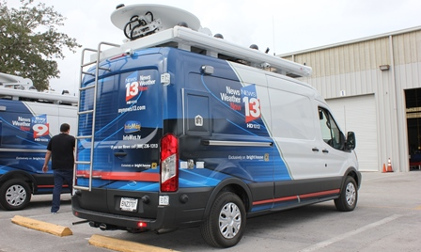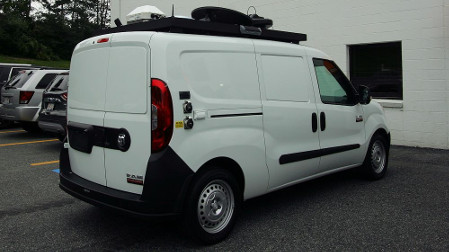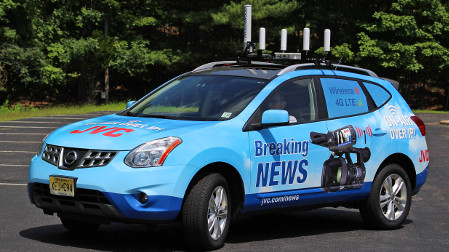ENG Trucks Evolve With Changing Wireless Landscape
SEATTLE—Going live is the life-blood of local and network television newscasts. Though bonded cellular backpacks have taken over some of the truck-born liveshot duty, there is still a good business to be done in building news vehicles. A number of news trucks with cutting-edge capabilities are rolling out to stations.
Satellite antenna agility can be a real plus for an SNG truck, which is why Brighthouse Networks, with stations in Orlando and Tampa, came to Frontline Communications in Clearwater, Fla. for four dual-band Ford Transit vehicles that feature AVL’s 1.2 Ka-Ku antennas.
Stephen Williamson, director of sales for Frontline, explained the advantage of being able to switch between Ka and Ku satellite links: “You would normally use a Ka satellite in your local market. Space-time with Ka costs less, though it is slightly more affected by rain fade. But if you’re doing out-of-town or cross country liveshots, let’s say your Orlando station is covering a game in Atlanta, or a location where maybe Ka was not approved for, they would go to the Ku.”

Brighthouse Networks tapped Frontline Communications to supply four dual-band Ford Transit vehicles that feature AVL’s 1.2 Ka-Ku antennas.
He also noted that Ka is designed for spot news, where Ku is better suited for doing long, multi-hour type productions.
“The AVL dual-band antenna features an automatic sliding feed that allows the operator to switch from Ka to Ku and back with the touch of a button inside the truck,” Williamson said. This means “there is no need to climb on top of the truck to switch the feeds manually, a potentially hazardous task.”
ROUGH AND READY
Get the TV Tech Newsletter
The professional video industry's #1 source for news, trends and product and tech information. Sign up below.
In markets that experience extreme weather events, a rough-and-ready vehicle platform with agile connectivity can be a real advantage. Jacksonville’s WJAX selected a Jeep Wrangler with both a Ka satellite dish and LiveU bonded cellular transmission. “They wanted a cutting edge camera system,” said Frontline’s Williamson, so they integrated “a custom software-programmed Live & Drive package with four POV cameras plus a roof mounted PTZ camera, all controlled by a handheld router controller with integral joystick.”
“The talent can choose which camera goes on air, switching clean and quietly between each camera, and control the roof mounted PTZ, all in the palm of his hand,” Williamson said. “The truck was also equipped with both Ka satellite and local weather systems, which can be displayed on the large rear monitor along with any other video source.”
The truck also features a cellular Wi-Fi system to allow Frontline and WJAX engineers to have remote access to control, monitor and troubleshoot any networked equipment in the truck.
EXTREME ENG CHALLENGES

For KVII-TV in Amarillo, Texas, AMT built the station a Ka satellite cell-bonded hyper van that allows them to switch between the cell and satellite connection to fit what works.
With apologies to Texas, cellular network and satellite-wise, a lot of the state is out in the middle of nowhere. For the Texas Panhandle-located KVII in Amarillo, “they’re not necessarily on one of the spot beams for the ViaSat satellite, they’re kind of off-beam a little bit,” said Steve DeFala, director of sales for Accelerated Media Technologies (AMT) in Auburn, Mass. “And there’s a lot of Texas that’s pretty sparse for cell coverage. The market has extreme ENG challenges.”
AMT built the station a Ka satellite cell-bonded hyper van that allows them to switch between the cell and satellite connection to fit what works. In KVII’s case, AMT partnered with LiveU for the bonded cellular equipment.
DeFala said that with the ViaSat antenna, even though they’re not perfectly within the beam, “they get phenomenal coverage. They’re able to roll anywhere they want around the country.”
For the truck platform, the station chose a Dodge ProMaster City.
Though there are many alternatives to point-to-point microwave, that liveshot technology is not dead yet. AMT has partnered with General Dynamics for the radios in the company’s ENGenesis LTE IP-Based ENG BAS system. Jacksonville’s WJXT is the first station in the U.S. to utilize the system, retrofitting its existing ENG trucks.
“It’s a replacement of the traditional COFDM video microwave, and works in the 2-gig licensed band,” said AMT’s DeFala. “Basically, we took [General Dynamics’] cell phone radio and pushed it into the licensed 2-gig BAS band.” The microwave system utilizes the station’s BAS licensed frequencies, paired with LTE technology. “You can run multiple trucks off the same frequency, at the same time, off the same receive site.”

JVC recently introduced its ProHD Wireless Bridge, a video-over-IP system designed for multicamera live broadcasts and compatible with JVC’s ProHD and 4KCAM streaming camera models. The ProHD Wireless Bridge comes equipped with a WB-MCA100 camera transceiver module, which plugs into the camera’s USB connector and allows cameras to operate up to 2,000-feet from the vehicle-mounted base station.
The system provides a complete bidirectional ability from their trucks to their studio, and back again. “So every truck is an extension of their in-house LAN Internet network, their station IP network,” he said. “So every truck has an address, every radio that’s in the truck has an address, everything that’s in those trucks has an address. So you could sit in the station, you could sit in master control at the TV station, and not only control the radio frequency …you can control the decoder that is receiving off-air video, control the truck’s PTZ cameras.”
Next up for the WJXT is a weather truck. “They’re going to be able to get off air cue, and separate weather graphics that the weather guy can do directly from the remote location, with no delay.
BUILDING A WIRELESS BRIDGE
For those stations that want to outfit a news vehicle without special retrofitting, JVC recently launched its ProHD Wireless Bridge, a video-over-IP system designed for multicamera live broadcasts and compatible with JVC’s ProHD and 4KCAM streaming camera models.
The ProHD Wireless Bridge comes equipped with a WB-MCA100 camera transceiver module, which plugs into the camera’s USB connector and allows cameras to operate up to 2,000-feet from the vehicle-mounted base station. The platform can also be used with handheld JVC cameras when paired with a smaller radio module, allowing for a 400-foot range.
Remote broadcasting is available with the platform courtesy of a built-in encoder that features Zixi error correction and variable bit rate control. With the encoder, operators can also monitor connection and outgoing stream quality status through the viewfinder.
There is also a WB-CELL200 cellular uplink that can receive signals from one or more field cameras to create a virtual private network (VPN). A mobile access point (WB-MAP100) with a separate high-gain omni-directional antenna is also available to receive signals and deliver them to the cellular uplink.
Operators can combine the ProHD Wireless Bridge with JVC’s BR-800 broadcaster and BR-DE800 ProHD decoder to create a mobile back haul system.
